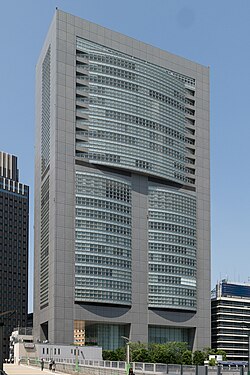Top Qs
Timeline
Chat
Perspective
East Japan Railway Company
Japanese railway company From Wikipedia, the free encyclopedia
Remove ads
The East Japan Railway Company[10] is a major passenger railway company in Japan and the largest of the seven Japan Railways Group companies. The company name is officially abbreviated as JR-EAST[11] or JR East in English, and as JR Higashi-Nihon (JR東日本, Jeiāru Higashi-Nihon; lit. 'JR East Japan') in Japanese. The company's headquarters are in Yoyogi, Shibuya, Tokyo, next to Shinjuku Station.[2] It is listed in the Tokyo Stock Exchange (it formerly had secondary listings in the Nagoya and Osaka stock exchanges), is a constituent of the TOPIX Large70 index, and is one of three Japan Railways Group constituents of the Nikkei 225 index, the others being JR Central and JR West.
Remove ads
History
JR East was incorporated on 1 April 1987 after being spun off from the government-run Japanese National Railways (JNR).[12] The spin-off was nominally "privatization", as the company was actually a wholly owned subsidiary of the government-owned JNR Settlement Corporation for several years, and was not completely sold to the public until 2002.
Following the breakup, JR East ran the operations on former JNR lines in the Greater Tokyo Area, the Tōhoku region, and surrounding areas.

Remove ads
Lines
Summarize
Perspective
Railway lines of JR East primarily serve the Kanto and Tohoku regions, along with adjacent areas in Kōshin'etsu region (Niigata, Nagano, Yamanashi) and Shizuoka prefectures.[13]
Shinkansen
JR East operates all of the Shinkansen high-speed rail lines north of Tokyo, with the exception of the Hokkaido Shinkansen which is operated by JR Hokkaido.[14]
The Tokyo–Osaka Tōkaidō Shinkansen is owned and operated by the Central Japan Railway Company (JR Central), although it stops at several JR East stations.[15] | 
|
Kanto region
These lines have sections inside the Tokyo suburban area (Japanese: 東京近郊区間) designated by JR East. This does not necessarily mean that the lines are fully inside the Greater Tokyo Area.
|

|
Koshinetsu region
|

|
Tohoku region
|

|
Remove ads
Services
Below is the full list of limited express and express train services operated on JR East lines as of 2025.
Shinkansen
Limited express (daytime)
Limited express (overnight)
- Sunrise Izumo/Sunrise Seto (not operated by JR East, operated by JR Central and JR-West over the Tokaido Main Line, part of which JR East owns between Tokyo and Atami)[16]
- Train Suite Shiki-shima
Stations
During fiscal 2017, the busiest stations in the JR East network by average daily passenger count were:[17]
- Shinjuku Station (778,618)
- Ikebukuro Station (566,516)
- Tokyo Station (452,549)
- Yokohama Station (420,192)
- Shinagawa Station (378,566)
- Shibuya Station (370,669)
- Shimbashi Station (277,404)
- Omiya Station (255,147)
- Akihabara Station (250,251)
- Kita-Senju Station (217,838)
Remove ads
Subsidiaries

- Higashi-Nihon Kiosk - provides newspapers, drinks and other items in station kiosks and operates the Newdays convenience store chain
- JR Bus Kanto / JR Bus Tohoku - intercity bus operators
- Nippon Restaurant Enterprise - provides bentō box lunches on trains and in train stations
- Tokyo Monorail - (70% ownership stake)[18]
- East Japan Marketing & Communications
Remove ads
Sponsorship
JR East co-sponsors the JEF United Chiba J-League football club [citation needed], which was formed by a merger between the JR East and Furukawa Electric company teams.
Carbon emission plan
JR East aims to reduce its carbon emissions by half, as measured over the period 1990–2030. This would be achieved by increasing the efficiency of trains and company-owned thermal power stations and by developing hybrid trains.[19]
Alleged revolutionary front
The Tokyo Metropolitan Police Department has stated that JR East's official union is a front for a revolutionary political organization called the Japan Revolutionary Communist League (Revolutionary Marxist Faction). An investigation of this is ongoing.[when?][20]
Culture foundation
The East Japan Railway Culture Foundation is a non-profit organization established by JR East for the purpose of developing a "richer railway culture".[21] The Railway Museum in Saitama is operated by the foundation.
Bids outside Japan
JR East held a 15% shareholding in West Midlands Trains with Abellio and Mitsui that commenced operating the West Midlands franchise in England in December 2017.[22][23] JR East sold their stake to Abellio in September 2021.[24] The same consortium were also listed to be bidding for the South Eastern franchise.[25][26]
References
External links
Wikiwand - on
Seamless Wikipedia browsing. On steroids.
Remove ads


